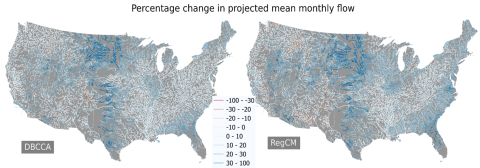
Dataset Overview
This dataset presents an ensemble of streamflow projections produced by the SECURE Water Act Section 9505 Assessment for the US Department of Energy (DOE) Water Power Technologies Office (WPTO). Multiple Global Climate Models (GCMs) from the Coupled Models Intercomparison Project phase 6 (CMIP6) are downscaled using either statistical (DBCCA) or dynamical (RegCM) downscaling approaches based on two meteorological reference datasets (Daymet and Livneh). Subsequently, the downscaled precipitation, temperature, and wind speed are employed to drive two calibrated hydrologic models (VIC and PRMS). The total runoff projections are then routed through the Routing Application for Parallel computatIon of Discharge (RAPID) routing model to produce an ensemble of streamflow projections across 2.7M NHDPlusV2 stream reaches over the conterminous United States (CONUS). Since the effects of human regulation and management have not been included in the modeling framework, these streamflow can only represent our best estimates of naturalized (or unregulated) flow. Further streamflow bias-correction may be needed for regions with relatively poor modeling skills. For more details on streamflow simulation procedure, please refer to Ghimire et al. (2022a) and Ghimire et al. (2022b).
Data Coverage:
Previous version (V1): This initial dataset included six selected CMIP6 GCMs: ACCESS-CM2, BCC-CSM2-MR, CNRM-ESM2-1, MPI-ESM1-2-HR, MRI-ESM2-0, and NorESM2-MM, for both 1980-2019 baseline and 2020-2059 near-future periods under the high-end (SSP585) emission scenario.
NEW in this extension (V1.1): Utilizing only DBCCA and Daymet, the projections of these six GCMs are extended to the 2060-2099 far-future period and across three additional emission scenarios (SSP370, SSP245, and SSP126). A seventh CMIP6 GCM EC-Earth3 is also added.
Complete Streamflow Simulation for 2.7M CONUS Reaches: The complete daily/monthly/annual ensemble streamflow for all 2.7M CONUS reaches can be accessed using Globus through https://doi.org/10.13139/OLCF/2318650.
Selected Streamflow Simulation for Points of Interest (POI): In this subset, a summary of streamflow projections are provided at daily, monthly, and annual timescales for Points of Interest (POI) that include US Geological Survey (USGS) stream gauges, Non-Powered Dams, Hydropower Infrastructure - LAkes, Reservoirs, and RIvers (HILARRI), Existing Hydropower Assets (EHA) Plant Database, 2023, Hydropower Energy Storage Capacity Dataset, and other locations requested by the users. The file 9505V3Flow_Download_Links (xlsx) provides all the links for downloading the data in the .nc format. The 9505V3Flow_POIs (xlsx) provides a list of COMIDs associated with NHDPlusV2 network corresponding to these POIs. Users can download the data individually using the download links provided in 9505V3Flow_POI_Download_Links (csv). The data dictionary is provided through the 9505V3Flow_Data_Descriptions (csv) file.
Selected Monthly/Annual Streamflow Simulation for 2.7M CONUS Reaches: In this subset, monthly and annual streamflow projections are provided for all 2.7M CONUS reaches. The file 9505V3Flow_Download_Links (xlsx) provides all the links for downloading the data in the .nc format. Users can also download the data individually through 9505V3Flow_CONUS_Download_Links (csv). The data dictionary is provided through the 9505V3Flow_Data_Descriptions (csv) file.
References:
Ganesh R. Ghimire, Carly H. Hansen, Sudershan Gangrade, Shih-Chieh Kao, Peter E. Thornton, and Debjani Singh. 2022a. Dayflow: CONUS Daily Streamflow Reanalysis, Version 1. HydroSource, Oak Ridge National Laboratory, Oak Ridge, Tennessee, USA. https://doi.org/10.21951/Dayflow/1847639
Ghimire GR, Hansen C, Gangrade S, Kao SC, Thornton PE, Singh D. 2022b. Insights from Dayflow: A Historical Streamflow Reanalysis Dataset for the Conterminous United States. Water Resources Research. https://doi.org/https://doi.org/10.1029/2022WR032312